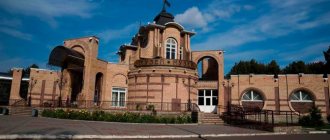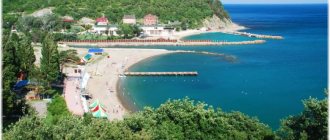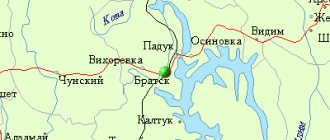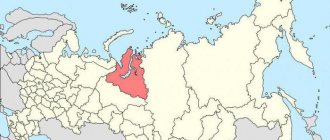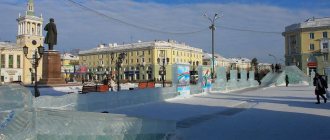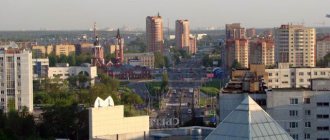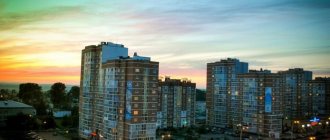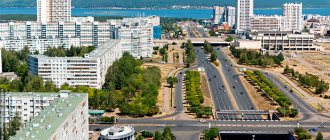Walking tour of Syktyvkar
The city is very compact, and all life is concentrated on Kommunisticheskaya Street (colloquially Kommuna), connecting the station and the Sysola River. Along it you can take a standard walk for small regional centers from the station to the river (3 km). The station itself (1964) is an unfinished Stalinist classic, and the Commune is a street with several squares, built according to all the rules of classical urban development. First there will be Khrushchev and Brezhnevka buildings, decorated, however, with national ornaments and panels that you will not find in other cities of Russia. The first major intersection with Oktyabrsky Prospekt is marked by the People's Friendship Stele and the local university. Next come the official institutions, the Opera House (1968), followed by the monument to Ivan Kuratov and fountains, the Pedagogical Institute (1938).
The center of the city is Stefanovskaya Square, where you will see typically Soviet buildings: the administration of the republic (16-story building built in 1961), the Philharmonic, the State Bank (1932), the drama theater (1932, architect Shcherbakov, constructivism), as well as a lot of walking townspeople and reindeer. Here you can also go to the history department of the National Museum of the Komi Republic (Lenin St., 57). Continuing further towards the river along Kommunisticheskaya Street, you have the opportunity to visit the nature department (No. 6) and the ethnography department of the same museum (No. 2). Perhaps the ethnographic section is the most interesting, where you can examine a fragment of a traditional hut-“kerka”, an idol of the Nenets from the shores of the Kara Sea made of wood, which nature has endowed with a “draconian” appearance, a collection of Permyak amulets, embroidery and knitting, differing in patterns depending on the place of production . Both departments are occupied by former merchant shops of the 19th and 20th centuries.
Communist Street will end at the coastal Kirov Park (a birch grove), and around the corner on the right is the National Gallery of the Komi Republic (Kirova St., 44), where paintings by Levitan, Aivazovsky, Savrasov, icons are presented, and in the adjacent territory there is a regularly replenished park sculptures on Finno-Ugric themes. The gallery is located in the building of a former religious school (1890, architect V. Fedorov). If you turn left from Kommunisticheskaya, you will see a huge building of the Republican Ministry of Internal Affairs (Kirova, 38, 1938, architect Zikeev) with an eight-column portico. From the park there is a good view of the village across the river on an island between Sysola and Vychegda. There is a private sector and a small beach.
Sometimes it seems to city residents that familiar streets have not changed at all for decades. To refute this opinion, BNK walked through the streets of the Komi capital this summer and compared them with panoramas taken in 2011. The result is material that shows what the city was like just seven years ago and how it has changed now.
Photo by Sergei Parshukov and Yandex.Maps service
The Yandex.Maps service stores panoramic photographs of Syktyvkar taken in 2011. Walking around the city online, we see the capital of Komi as it was seven years ago. A BNK photojournalist took photographs of the current city from the same angles as Yandex specialists.
The center of the Komi capital really changed gradually and almost imperceptibly. Advertising structures have disappeared from some buildings, yellow minibuses have stopped flashing and billboards with calls to visit the store and take advantage of the discount are no longer visible.
There are no yellow GAZ vehicles at bus stops either. You can often see huge NefAZ trucks there. And the stops themselves have changed almost throughout the city. Instead of complexes with stalls filled with essential goods, plastic structures appeared to protect passengers from the rain. Those stops that have not yet been dismantled have simply been cleared of advertising. The kiosks there are empty.
On the site of the former Parma cinema, or rather, which was hidden for many years by a vacant green fence, a shopping center of the same name with a large promenade in front of the main entrance has grown up. The massive building finally pushed the once popular Kalevala shopping center to the second line.
Even the native residents of Syktyvkar will find it difficult to remember what the playground in front of the Children's World looked like without the play area, which at one time caused a lot of controversy. Despite thousands of dissatisfied voices from townspeople, it is still popular with children and their parents.
On Sovetskaya Street, instead of a shady alley, as part of the Urban Legends project, a recreational area with benches and a new attraction - the chest of the Sukhanov merchants - appeared.
Another result of “Urban Legends” is Pokrovsky Boulevard in Orbit. Over the years, it has become much more like a recreation area for the whole family, acquiring paths, benches, lighting and its own art objects.
And in Kirovsky Park, instead of the crumbling bank, the future embankment was opened for walking. In general, the park looks tidier after reconstruction and two years of work.
Michurinsky Park was also lucky, as it had been neglected for many years. Even from the road you can see what condition it was in before and what it was like in 2018.
The city has changed noticeably thanks to active development both in the center and in residential areas. Near the Republican stadium, instead of the wooden houses that stood there not so long ago, a construction fence appeared. It was planned to build a multi-storey residential complex on this site, but work has been frozen for now. The fence is periodically used as a place to place social advertising and posters for upcoming sporting events.
In 2011, the Swallow's Nest residential complex was still under construction, and the future Timan was not yet visible from behind the trees.
On the site of a mothballed construction site in the center where the Kaleidoscope residential complex was supposed to grow, the construction of another complex, Tokyo, began.
Instead of a market, a huge residential complex appeared in the Orbit microdistrict. At one time, local residents opposed its construction. Among the reasons, they cited the cheapness of food that could be bought in tents, and traffic jams that could arise due to the appearance of another “anthill” in a residential area of the city. It is unknown whether the fears of residents of nearby houses were justified.
The once completely “wooden” Karl Marx Street has noticeably changed. In addition to a dozen new high-rise buildings, including the notable London, a new building for clinic No. 1 was built there and bus stops were installed.
Other social facilities were also built in the city. One of the largest projects is the development of Petrozavodskaya Street. An Orbita swimming pool has appeared on a huge vacant lot next to Khimbil, and a school with 1,200 places is being built nearby.
The culture of huge shopping and entertainment centers has also penetrated into Syktyvkar. “Maxi” and “June” opened on Oktyabrsky Prospekt, and the Lenta hypermarket opened on Sysolskoye Shosse.
What else to see in Syktyvkar?
We return from the park along the same Kommunisticheskaya street and turn left onto Sovetskaya. There is the center of folk culture of the Izhma Komi people “Izva” (Sovetskaya St., 28 a), where you can get acquainted with the peculiarities of this Komi subethnic group, which was formed on the basis of mutual influence of the Komi proper, Russians and Nenets. Let's walk along Sovetskaya in the other direction, again passing the intersection with Kommunisticheskaya. You will also be immersed in a corner of pre-revolutionary Ust-Sysolsk, mixed with Soviet-era houses. On the right along the way: the Oplesnin house (1892, No. 25), now the FSB office, the house of the merchant Komlin (No. 21, early 20th century), the National Library with Corinthian columns (No. 13, 1958). And two blocks later, on the corner with Ordzhonikidze Street, you will see the symbol of old Syktyvkar - a ten-meter fire tower (1907), a turret with a large weather vane and a dial that glows unusually brightly at night. The clock of this landmark of Syktyvkar strikes the time every hour from 8 to 22 with music. Inside you can visit a fire-technical exhibition. In general, fire towers in the wooden North were very relevant and before the revolution they were the high-rise dominants of cities. From the tower you can go down a block along Ordzhonikidze to the park - on the left will be the oldest stone building in the city, the Sukhanov House (1804, No. 2), which houses the literary museum. That's all, you can climb up Ordzhonikidze. Past the former women's gymnasium, and now the lyceum (No. 14, 1913, architect Androsov), you will come out onto Lenin Street, and on the right you will see the large beautiful Cathedral of Stephen of Perm (1996-2001). From here, turn two more blocks to the left, and you will again come out onto Stefanovskaya Square.
Outside the center, most of the villages that make up Syktyvkar are completely uninteresting. We can highlight the village of Ezhva (17 km to the north) - a remote but very important part of the city, where the Syktyvkar timber processing complex (1963-1968), the largest timber processing complex in Europe, is located, producing more than 40% of newsprint and cardboard in Russia. The southern suburb of Syktyvkar - Kirul, built up with wooden huts. There is a bus station and an airport there - one of the few in Russia located almost in the city center (another is currently being built, 30 km from the city). Near the bus station is the Ascension Church (1811).
See also:
- Komi Republic
- Ukhta
- Vorkuta
How to get there and where to stay
Fifty hotels in Syktyvkar with a wide range of prices will not leave a tourist without a roof over his head. The most expensive three-star “Palace”, located on the upper floors of the “Torgovy Dvor”, and “Avalon”, near Stefanovskaya Square, will charge up to 4,600 rubles for a double room. (A suite costs the same for one person). The price includes a spacious room, modern interior, panoramic views of the city, free breakfast, parking, wi-fi.
But it is not difficult to find more budget options for hotels in Syktyvkar, also in the city center, located at a convenient distance from the airport and train station. “Pelys” will set a price of 2400 for two, with breakfast included and free internet. Mini-hotels, guest house "Siyanie" (with a shared kitchen) will also ask 1900 - 2000 for a double room. The Tourist Luxury apartment offers accommodation for a company (or family) of four for 1,500 in a room with its own kitchen.
You can get to Syktyvkar from Moscow both by rail and by air. Direct trains leave Moscow every fourth day, the journey will take exactly 24 hours. Daily train service is only possible with tedious transfers. It’s easier to buy air tickets to Syktyvkar from Moscow. The price is not much higher, five daily departures are made from three Moscow airports.
House with storage shed
The next object of the excursion was house No. 45 on Zavodskaya Street - a two-story building where shopping arcades used to be located. Its peculiarity, according to Sazhin, is the attached storehouse, thanks to which merchant carts could unload goods directly into the house.
— Kirul is located at the bend of the Sysola River. A lot of houses that were in old Ust-Sysolsk on the shore simultaneously served as trading houses, that is, goods were stored in them. Storage sheds [utility premises, food warehouse] were built right next to the house. In photographs of old Ust-Sysolsk you can see huge storage sheds just standing on the shore, but here the storage shed is attached to the house. There is no other house in the city where the storage shed is preserved as an extension to the house. What's so good about this attached storage shed? This ledge is very good for unloading and loading in order to go down to Sysol and unload onto ships. The most important connection of Ust-Sysolsk with the rest of the world is only one thing - the river. Goods arriving here are unloaded, stored and sent to stores,” Sazhin explained.
House on Beregovaya, 73
The house where the history of Vyacheslav Slyusarev’s family began in Ust-Sysolsk. More details in the video:
The “Walking around Ust-Sysolsk” project began in March 2016. Historians, journalists, and researchers tell Syktyvkar residents about the history of the city, each time choosing one topic. The last excursion from the series “Wooden Syktyvkar, which we will soon lose” was dedicated to typical urban development of the 19th century. In total, more than 30 excursions took place. They take place once or twice a month.
* The Memorial Organization acts as a foreign agent. We put this mark at the request of the Ministry of Justice and Roskomnadzor. We do not agree with laws requiring this labeling.
House of Mars
This house in Kirula is famous for the legend of church treasures buried in the garden. Igor Sazhin told how during his student years he himself tried to find the treasures of this place.
— In 1988, two students learned from a teacher that an old man named Mars lived in Kirula. Strange name. We came to the police, where we learned that only Mars lived in Syktyvkar. The grandfather of this Mars, when they dismantled and destroyed the Kirula Church, took church books and icons and buried them in his garden. Students came to Mars. Mars meets and says: “Yes, this is my grandfather. There is a barn here, there is firewood in it. Pull out the wood, dig under the shed. Many seekers came before you, but no one wanted to carry firewood.” We look at a huge shed with firewood; there was work for several days. Then we just went up to the attic of this Mars.
In the attic, students found old newspapers, one of which, “Kopeyka” from 1916, sent to Ust-Sysolsk from St. Petersburg, Igor Sazhin showed to the townspeople on an excursion.
Deacon's House
Igor Sazhin began his part of the tour from the deacon’s house on Zavodskaya Street. The architectural feature of the house is that its log masonry goes right under the roof:
“Unfortunately, this is already a dying, crumbling monument. What's great about this house? It shows the peculiarity of Kirul's architecture. In Syktyvkar you will find, perhaps, another such house. There are several of them in Kirula, about six or seven. What's unusual about them? Its peculiarity is in the log masonry. She goes right to the roof. There is practically no attic there [in the house]. This is a very unusual construction system, a local Kirula tradition brought from some village. The roof lies on logs. The most interesting thing is the northern structure, thanks to it the house has not yet collapsed,” said Igor Sazhin.
More details in the video:
